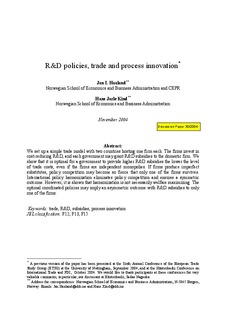R&D policies, trade and process innovation
Working paper
Permanent lenke
http://hdl.handle.net/11250/162780Utgivelsesdato
2004-11Metadata
Vis full innførselSamlinger
- Discussion papers (SAM) [657]
Sammendrag
We set up a simple trade model with two countries hosting one firm each. The firms invest in
cost-reducing R&D, and each government may grant R&D subsidies to the domestic firm. We
show that it is optimal for a government to provide higher R&D subsidies the lower the level
of trade costs, even if the firms are independent monopolies. If firms produce imperfect
substitutes, policy competition may become so fierce that only one of the firms survives.
International policy harmonization eliminates policy competition and ensures a symmetric
outcome. However, it is shown that harmonization is not necessarily welfare maximizing. The
optimal coordinated policies may imply an asymmetric outcome with R&D subsidies to only one of the firms.
Utgiver
Norwegian School of Economics and Business Administration. Department of EconomicsSerie
Discussion paper2004:30
